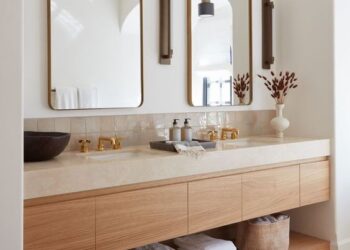The most interesting thing about The Block is the fact that there is nothing like it. Nothing like it on TV and nothing like it in real life. It’s a triple-edged sword, with several agendas and requirements of the contestants. Judging these requirements is as much of a balancing act as performing them. The Block judge, Darren Palmer, shares the top lessons you can learn from the block before taking on the same challenges in real life.

Image via pinterest
The contestants need to:
Renovate a house
Design interesting rooms to win cash
Complete challenges to win cash
Sell property at Auction
All of these things require a different focus and lessons to be learned…
The first and probably most important thing is to understand what the end result will be. To prepare, to plan and research so that you have a clear and defined approach to the spatial, aesthetic and finishing requirements of a home to appeal to the particular market must be your primary focus. Knowing the market and what the upper end of the buyer in the area will pay for a well-finished home will dictate how much you can plan to make on the sale. knowing the buyer also lets you understand what they need, to live the way they desire. Your aim should be to meet their expectations and exceed them only slightly. Phil and Amity did this with excellent results.
Designing rooms in this competitive environment to win cash to help complete your home is a uniquely Block concept. It’d be nice if in a normal renovation situation someone gave you prize money for making an amazing space.
Consistency and congruence throughout the home is the key to balancing the strong design focus, and the sale-ability of the property. Having an overarching idea that is applied throughout the property, with a considered and planned colour scheme helps to tie together the home and present it in its best possible light. We have seen the result of creating an interesting but unfocused home (which narrows the market, value and saleability of a home) in the most recent auctions in the instance of Mark & Duncan.
Completing challenges to win in the latest series did give the contestants valuable opportunities to test run their plans in Bathroom Week and learn new skills. In the real world, your best way to test run your plans is to gather a schedule of finishes and inclusions and keep them in a folder or scrapbook, either on your computer or in hard copy. Seeing everything together really allows you to weed out the elements that don’t fit. Samples, images and swatches of tiles, carpets, wood and paint colours (to name a few) are the best way to assess inclusions as you can see the real colour and finish whereas a photograph may present something in a more desirable light than the real thing.
Selling a property at auction requires getting all of the above items right, at a price point, the market will respond to, whilst selling at a price that gives you a worthwhile profit. At an auction, one buyer is almost always not enough. You need a bidding frenzy of emotive, emotionally attached buyers who have fallen in love with the property, with less regard for the price. Painting a clear picture for the buyers of how they will slot their lives easily into the home really is the key, with styling the home a major part of painting that picture. Providing furniture, art, soft furnishings and elements of everyday life allows potential buyers to see their lifestyle without any interpretation or imagination. Completing that picture hooks the buyer and helps allay feelings of fear and doubt.
The lessons to learn while watching the upcoming series are valuable. Learning from the experiences and mistakes of contestants will give you a better understanding of how to make the most of your own renovations and gain the most profit from your own sales.
Look forward to seeing you back on the TV soon.
By Darren Palmer www.darrenpalmer.com



















